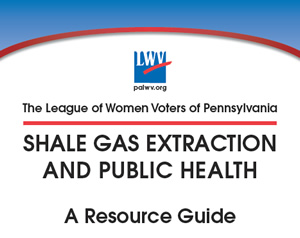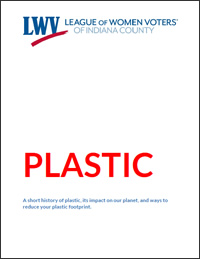By Heather Harr and Betty Tatham
Download the Program Book (pdf)

Click the above image to view our informative “Shale Gas Extraction and Public Health: A Resource Guide”
The League of Women Voters of Pennsylvania held its first “Shale Drilling and Public Health: A Day of Discovery” conference at Pittsburgh’s Heinz History Center on November 23, 2013, with more than 250 people in attendance. The event featured presentations on the latest research regarding shale drilling and public health by academics and government researchers from the Pittsburgh area and across the country.
Susan Carty, President of the League of Women Voters of Pennsylvania welcomed the audience, speaking of the League’s mission and studies in the areas of environment and public health. She also thanked the Colcom Foundation for their two grants to the League’s Citizen Education Fund which made the conference and other League programs in western Pennsylvania possible. Opening remarks were given by Bernard Goldstein, M.D., Emeritus Dean/Professor, University of Pittsburgh Graduate School of Public Health.
A keynote presentation by Anthony Ingraffea, University of Pittsburgh Graduate School of Public Health and international speaker on climate change, well construction, fracture mechanics and computer modeling discussed recent research on directional hydraulic fracturing on well integrity in Pennsylvania. Keynote speakers also included Michelle Bamberger, M.S.,D.V.M. a veterinarian and consultant in private practice and Robert Oswald, Ph.D., Professor of Veterinary Medicine at Cornell University whose focus was human and animal health. They announced the August 2014 publication of their book “The Real Cost of Fracking: How America’s Shale Boom Is Threatening Our Family’s Pets and Food.”
Future research on health impacts near natural gas drilling was the topic of Reynold Panettieri, M.D., Professor of Medicine at the University of Pennsylvania and Deputy Director of the Center of Excellence in Environmental Toxicology there. “Shale Industry Best Practices” were described by Andrew Place, Center for Sustainable Shale Development, who has worked in industry and government. Groundbreaking research on worker safety was shared by John Snawder, Ph.D. DABT, who is a toxicologist and Leader of the Biomonitoring Research Team at the National Institute for Occupational Safety and Health (NIOSH). The full program listing all presenters follows this summary.
The Health Fair with booths outside the auditorium was a popular part of the conference. Exhibiting organizations included the Allegheny County Health Department, demonstrations of water and air monitoring devices from Carnegie Mellon University’s Create Lab and others, FracTracker Alliance’s GPS well data, and agricultural/food organizations were also represented.
The new “Shale Gas Extraction and Public Health Resource Guide” made its debut at the conference. This 25-page Resource Guide was researched and written by Indiana League member Vera Bonnet with help from the Shale and Public Health committee. Copies of the guide are available for distribution. The Resource Guide has already been shared with two professors who will be using it as a resource document for their course on shale next semester. The Resource Guide can be downloaded from our website, http://shalepalwv.wpengine.com.
The entire program was professionally videotaped and videos of speaker presentations will be available on the YouTube channel early next year. Our Chatham University intern Jessica Chow also conducted interviews with speakers and will be putting together some videos which will also be posted to our YouTube channel and linked from our website.
The conference was organized by the LWVPA’s Shale and Public Health Committee, a 16-member committee made up of members from the Leagues of Women Voters of Greater Pittsburgh and members from 4 other counties. Written, e-mail and verbal evaluations and comments about the conference have been overwhelmingly positive with many requests for additional League sponsored educational opportunities. The audience consensus was that they discovered a lot!
To learn about our conference from the perspective of a visiting medical doctor from West Virginia, see Dr. Wayne Spiggle’s comprehensive article in the West Virginia Highlands Conservancy’s newsletter, “SHALE DRILLING AND PUBLIC HEALTH” on page 6 of the Highlands Voice, December 2013 edition. Dr Spiggle is a member of the W.V. Highlands Conservancy’s board of directors, www.wvhighlands.org .

